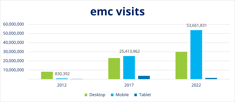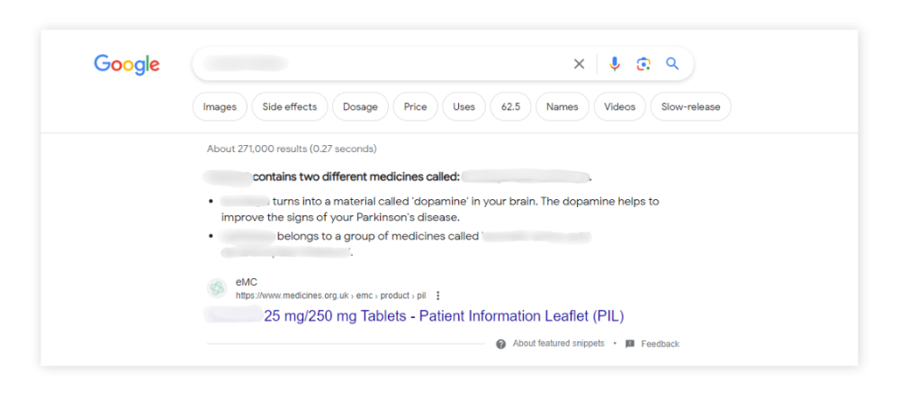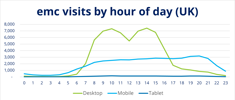Blog
The patient’s medicines information journey: what do we know about the shift to digital?
Feb 8, 2024
Datapharm’s Product Manager for emc, John Moreland, provides his insight on the patient’s journey for digital medicines information, and the trends we’ve seen develop over the past decade.

John Moreland
Product Manager (emc), Datapharm
How we access and engage with our own health information is continuing to evolve. Figures from 2023 show that more than 4 out of 5 GP practices in England are giving patients access to their new health records online, encouraging them to use the NHS App and online resources.
This improved access to information, combined with an apparent desire to understand more about our own health and medication, makes for an increasing trend in using digital medicines information and online services. With this in mind, an effective digital strategy to improve patient outcomes becomes ever more important.
One scenario where a digital approach can help is the interface between a patient and medicines information. If we take, for example, the Patient Information Leaflet that comes with a medicine, there are a number of issues with the paper leaflet, such as understanding engagement and that the information may go out of date during the life of the physical copy. Such issues can be mitigated by use of ePIL, a user-friendly digital format introduced by emc.
For Pharma, understanding patients’ habits and the way they engage with medicines information from a digital resource can better help to:
- Validate how and when to engage with them;
- Identify trends in what medicines patients are looking for information about and;
- More specifically, how they are interacting with Pharma’s medicine information.
As the provider of emc, Datapharm can provide some unique insight into how patients are engaging with medicines information today, and how this has changed over time.
Digital usage: Then and now
emc has been providing digital medicines information for over 25 years, firstly only to healthcare professionals and then to patients too. Previously it had only been available as hard copy with all the logistical issues associated with producing a high-volume book run and ensuring the accuracy of information on thousands of medicinal products.
emc has earned an enviable reputation, especially within the healthcare community, registering an NPS score of 80 from HCPs in a 2022 user survey. It is a trusted digital source of information within a community that is still on its journey to fully utilise the advantages offered by engaging with patients in a digital domain.
We are all accustomed to having the answer to almost any question at our fingertips, and patients are no exception. They are turning to the internet to look for information about medicines which has been fuelled by smart devices and the ever-increasing speeds of home and mobile data connections. In 2012 most users accessed emc from a desktop/laptop computer, but this has changed. For many years the most used device is a mobile phone. In the 10 years from 2012 to 2022 the number of users accessing emc on a mobile device has increased by over 6000%.

How do patients find their medicines information today?
As the majority of emc users - both HCPs and patients - come to emc via a search engine such as Google or Bing, we work hard to make sure it is optimised for such traffic and that it is recognised as a trusted and authoritative source of medicines information.
With many years of metrics to analyse we have come to understand emc usage, and in particular the differences in how HCPs and patients use technology. One of the most striking distinctions between these user types is that most HCPs use a desktop/laptop device whereas patients mainly use mobile devices. Taking this hypothesis forward, we see that over 91% of patients come to emc through an organic search.

What are the trends in patient engagement with medicines information?
Analysis of emc traffic can provide interesting insight into patient behaviour. While HCP users are, unsurprisingly, most active during office hours, patients tend to increase their activity throughout the day, peaking in the evening with almost double the traffic at 8pm than at 7am.

We can see other trends, such as:
- Seasonality - An uptick in winter of views of information for flu vaccine and antibiotics for respiratory conditions
- Supply chain issues - Recent shortages of HRT and ADHD medications lead to patients looking for information on alternative medicines they may have been prescribed
What format do patients want their information in?
When patients were asked about their reasons for visiting emc in 2022, 29% said they hadn’t read or didn’t have the paper leaflet, highlighting the importance of supplying this information in an accessible, digital format such as ePILs. Furthermore, 52% of patient respondents said they’d like to see more medicines have patient information in ePIL format.
Interested in learning more about patient engagement?
emc has been long been established as a trusted source of regulated medicines information, with 54 million visitors annually viewing safety information on UK-licensed medicines. Publishing medicines information on emc also ensures that information from this database is distributed through to 3rd party providers, including medical information websites, medical publications and clinical decision support systems.
We survey patients and HCPs on emc annually, gaining insight into their medicines information journey and learning about how to better meet their demands for compliant, non-promotional content from Pharma. To discuss more about patient engagement with your product information, contact our team.
